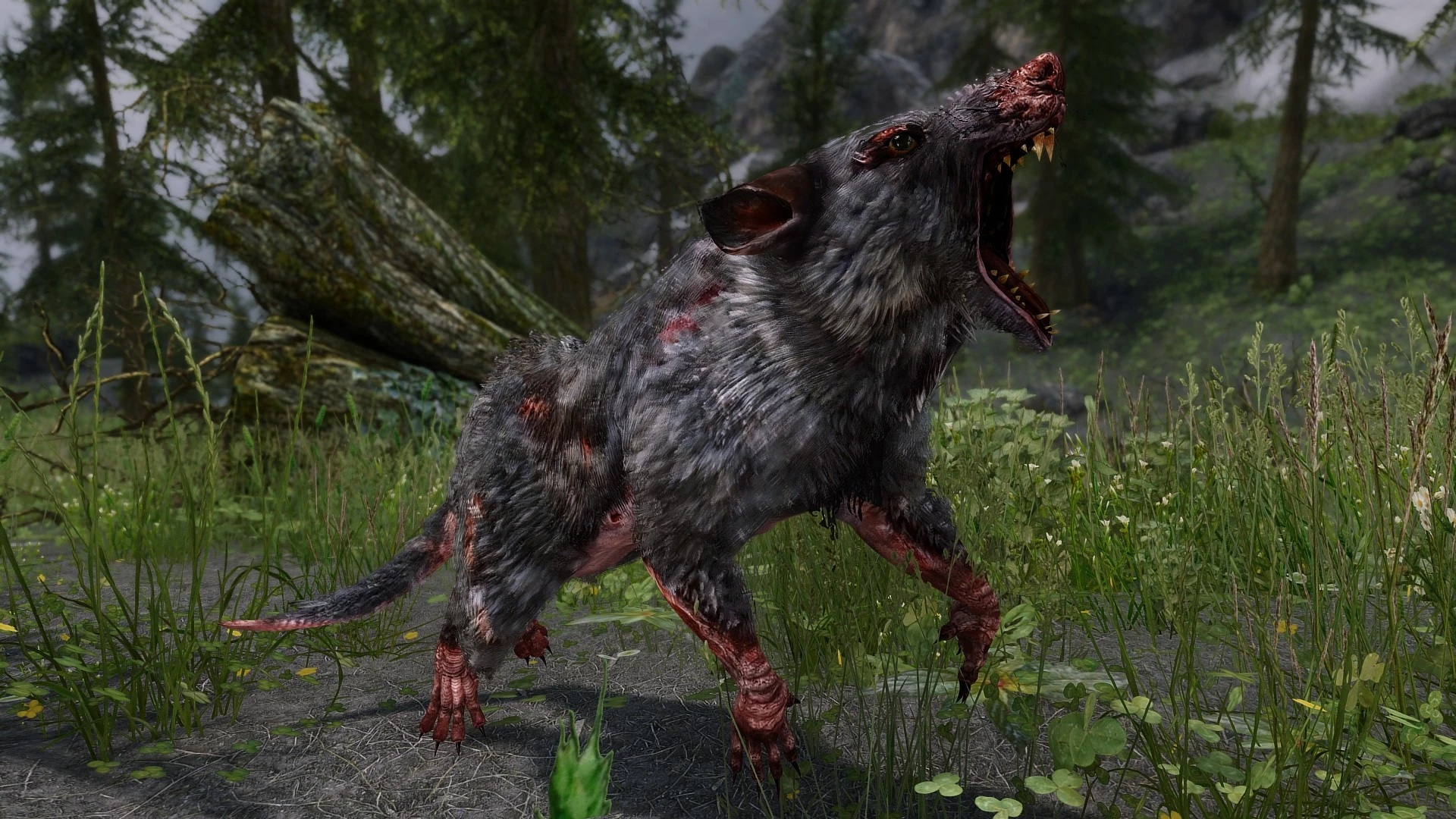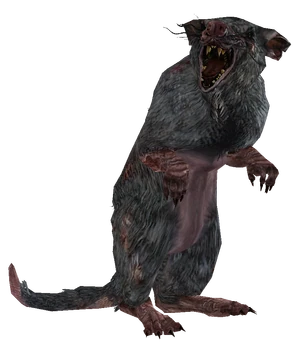Corpse Rat and Jackrat
It seems that everywhere you find a group of humans, you'll find a clan of rats hiding in the shadows. This history seems born out of opportunity for the rat, but humans have done their part to help them get around the world rather easily. This commensalism - a relationship where one species benefits, but the other receives little or no harm - is probably the result of the sloppy nature of humans. The flagship rat species, Rattus Rattus, once originated in India, and while some of its cousins hung around on forest edges and fields, many found a living chasing down humans and loitering around their encampments for scraps. In more modern times, Rats are everywhere – at least everywhere that humans are. In almost every big city in the world, rats are eating human rubbish, breeding in human buildings, and running through city streets.
Even on a different planet, the relationship between man and rodent, be it good or not, has changed very little. Even if the rodent's in question have.
Scourge of the world, the pestilence bringer, ever-present yet hardly welcome.
Oversized version of Black Rat (Rattus Rattus), many titles are given to the Corpse Rat, a large deadly rodent-like creature species found within the deep darkness of caves, sewers and chasms surrounding many parts of Elysium.
In the popular opinion, Corpse-Rat are considered dangerous vermin, pests associated with death and disease. More feral and are prone to carry more diseases then the common rat. Opportunistic omnivores that feed on all matters of filth as well as the sick, weak dying or already dead, not much separates the Corpse-Rat from other rats other than size and fearsomeness.
Corpse-Rats' disgusting diet causes their saliva to usually be laced with a cocktail of often quite dangerous pathogens, most of which are unknown to even science. Even if prey was to survive the initial attack, they are doomed for a slow, painful agonizing demise by horrible disease. Despite however their nonexistent dental hygiene and highly aggressive nature, Corpse rats are fairly low down in the subterranean food chain kept in check by Corpsecleaner centipedes and a host of other predators looking to make a meal out of these rambunctious rodents. In fact, while they are known as pests, the Corpse-Rat is actually one of the largest-known food sources for predatory animals in the entire continent.
Large eyes allow them to see in near pitch black, low light conditions, and their large ears are perfectly tuned for listening to the sounds of prey who stumbled too far into the darkness. They have been known to travel above ground at night to attack wayward children, unsuspecting wildlife and loose pets. As a result they are often killed on sight and are often one of the common animals in the world to have bounties out on their heads.
Scourge of the world, the pestilence bringer, ever-present yet hardly welcome.
Oversized version of Black Rat (Rattus Rattus), many titles are given to the Corpse Rat, a large deadly rodent-like creature species found within the deep darkness of caves, sewers and chasms surrounding many parts of Elysium.
In the popular opinion, Corpse-Rat are considered dangerous vermin, pests associated with death and disease. More feral and are prone to carry more diseases then the common rat. Opportunistic omnivores that feed on all matters of filth as well as the sick, weak dying or already dead, not much separates the Corpse-Rat from other rats other than size and fearsomeness.
Corpse-Rats' disgusting diet causes their saliva to usually be laced with a cocktail of often quite dangerous pathogens, most of which are unknown to even science. Even if prey was to survive the initial attack, they are doomed for a slow, painful agonizing demise by horrible disease. Despite however their nonexistent dental hygiene and highly aggressive nature, Corpse rats are fairly low down in the subterranean food chain kept in check by Corpsecleaner centipedes and a host of other predators looking to make a meal out of these rambunctious rodents. In fact, while they are known as pests, the Corpse-Rat is actually one of the largest-known food sources for predatory animals in the entire continent.
Large eyes allow them to see in near pitch black, low light conditions, and their large ears are perfectly tuned for listening to the sounds of prey who stumbled too far into the darkness. They have been known to travel above ground at night to attack wayward children, unsuspecting wildlife and loose pets. As a result they are often killed on sight and are often one of the common animals in the world to have bounties out on their heads.
In addition to the Corpse Rat, another large rat species makes its home in the world's extensive landscape. However unlike its more aggressive cousin, this one makes it’s home in the comfort of a couch curled up in a lap, then a dank dirty sewer.
The Northern Jackrat, so named for their behavior of slapping their foot on the ground like a Jackrabbit when they are content, are the result of the North Arkaelian rat population being tainted by the magical fallout from the onslaught of warfare. However unlike Corpse-rat who evolved the same way, Jackrats, once derived from a variety of Fancy pet rats (Rattus domestica) , do not exhibit the same aggression that plagues their relatives, and instead have been domesticated as companions, adored and loved for their independent and loyal behavior, and high intelligence.
Not much separates the Jackrat from the Corpse-rat in terms of appearance. Much like the Corpse-rat, prolonged exposure to magical fallout has caused Jackrat to also double in size and age, with them growing to be the size of a medium sized dog, and where as their ancestor only sadly live only 2-3 years in captivity, Jackrats live almost triple that, ranging ages from 8-10 years, with the longest said to be almost 15.
One of the main differences in appearance between the two rodents is body-type. Jackrats are naturally a bit smaller and more “plump” then Corpse-rat, with Jackrat having a rounder face, slightly rounder ears and a more healthy look to them, lacking a natural loss of fur and diseased look which is prevalent in Corpse-rat.
They also behave differently, as Jackrats are highly social animals, while Corpse-rat tend to be on the more solitary side outside of breeding pairs. Because of this, Jackrats can be housed together regardless of sex, as males are not all that aggressive towards one another. The same can not be said for the territorial Corpse-rat, who usually act intensely aggressive to any sex regardless. Being derived from fancy rats also gives Jackrats the ability to come in many forms of pattern and color, that are not found outside in wild rat populations out-side of uncommon colors or morphs. Jackrats can also be taught to coexist with other household pets, whereas Corpse-rats are aggressive to anything and are more likely to kill then bond with their house-mates.
While they are known as pests, the corpse-rat is actually one of the largest-known food sources for predatory animals in the entire continent. It is a popular prey for larger creatures but it is also a very common meal to find cooked in a campfire.
Although the Corpse-rat are more common in Arkael, they can be found as far as the Southern Sea and across the ocean in Gudeth. This is because traders from the far north travel across the continent, inadvertently bringing them with them, similar to how rats once and still stowaway on trading ships. Because of this, Corpse-rats tend to live in a variety of places. They can nests in caves, sewers, and underground warrens, etc, and while many of them can be found out in the wilderness, where they will build nests deep in the forests, they can also be found burrowing in beaches, and when the tide rolls in, so do the burrowed animals.
Trivia
- Did you know, that despite being known as “Pinkies” much like their Earthen-Realm brethren, baby Jackrat pup are most popularly known as “squeakers”. This is because at such a young age the babies are much more vocal than their adult counterparts. Babies who start growing their hair out and start exploring are nicknamed “Thumpers” as this is around the age where they become more accustomed to slapping their feet on the ground to express their emotions rather than become vocal. Despite being silent, it is believed that these rats emit frequencies in low noises, similar to how an Elephant emits low frequencies with their rumbling, the sound traveling large distances being virtually undetectable outside of those trained to listen, or their own kind.
Domain: Eukaryota
Kingdom: Animalia
Phylum: Chordata
Class: Mammalia
Order: Rodentia
Family: Muridae
Genus: Rattus
Species: R. rattus Arkaelie







Comments